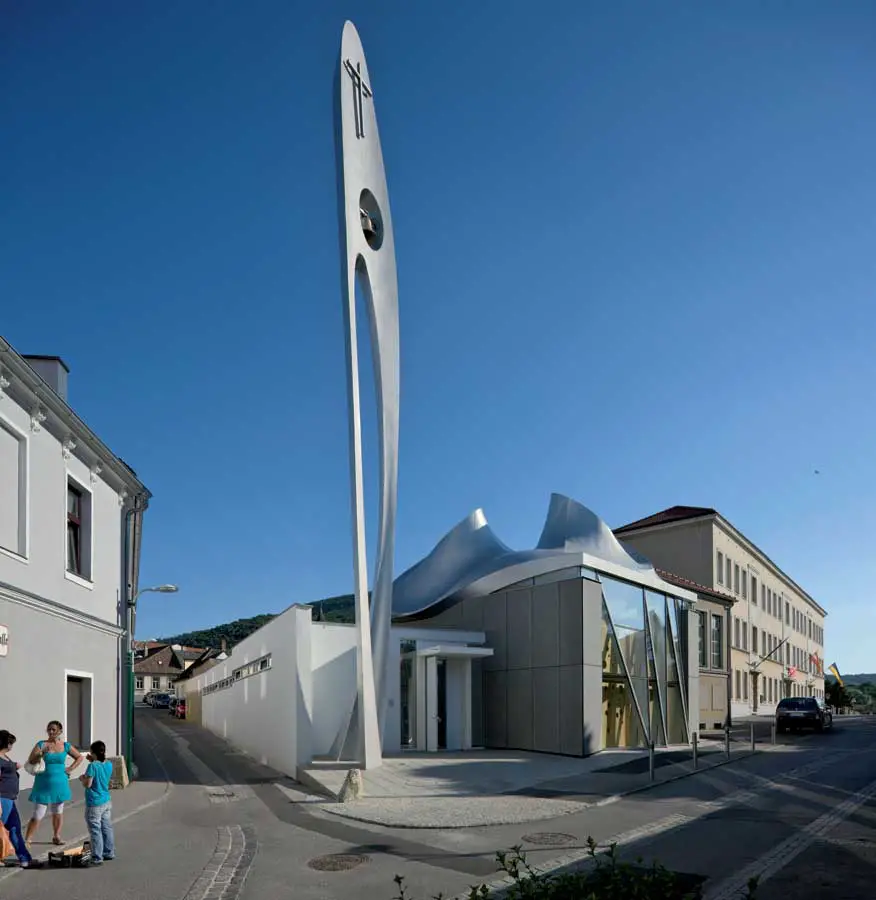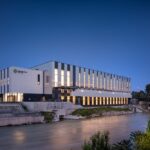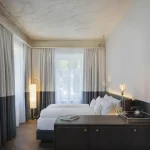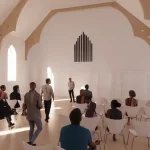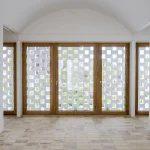Hainburg Church, Martin Luther Kirche, Austria Religious Building Project, Wolf D. Prix Design
Hainburg Church Austria : Martin Luther Kirche
Austrian Religious Building design by COOP HIMMELB(L)AU, Architects, Vienna
post updated 18 April 2022
Martin Luther Kirche Hainburg, Austria
Dates built: 2008-11
Design: COOP HIMMELB(L)AU
Overall view with bell tower / Gesamtansicht mit Glockenturm:
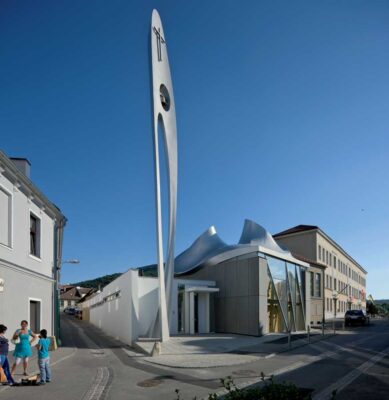
photo © Duccio Malagamba
Martin Luther Church
Vienna, 16 August 2011
Martin Luther Church Hainburg completed Lower Austrian Decoration of Honor for Wolf D. Prix
Wolf D. Prix, Design Principal of COOP HIMMELB(L)AU received the “Komtur Cross in Silver of the Decoration of Honor for Services to the State of Lower Austria” on 29 June 2011 from the hands of the governor of Lower Austria Dr. Erwin Pröll during a ceremonial act in St. Pölten, Lower Austria.
“Wolf D. Prix is an internationally renowned architect who has set milestones and achieved a great lifework” said governor Pröll in his laudation. He also said thank you for his willingness to architecturally enrich Lower Austria.
“To have grown up in Lower Austria left a permanent impression on me” said Wolf D. Prix in his acceptance speech. “The distinction of the federal state Lower Austria is very exciting for me”.
Prix had donated the design for the shortly completed Martin Luther Church Hainburg to his hometown.
In less than a year a protestant church was built in the centre of the Lower Austrian town Hainburg. The shape of the building is derived from that of a huge “table”, with its entire roof construction resting on the legs of the “table” – four steel columns. Another key element is the ceiling of the prayer room: its design language has been developed from the shape of the curved roof of a neighboring Romanesque ossuary – the geometry of this century-old building is translated into a form, in line with the times, via today’s digital instruments.
Like other projects of COOP HIMMELB(L)AU the roof elements of the church building were assembled in a shipyard. The implementation of the intricate geometries required specific technologies of metal-processing and manufacturing only available in shipbuilding industry. The reference to shipbuilding is at the same time also reminiscent of Le Corbusier who served as an important role model, not least because of his La Tourette monastery.
Martin Luther Church Hainburg, Austria
Martin Luther Kirche Hainburg
2008-11
Design: COOP HIMMELB(L)AU
Steelroof and skylight / Stahldach mit Oberlicht:
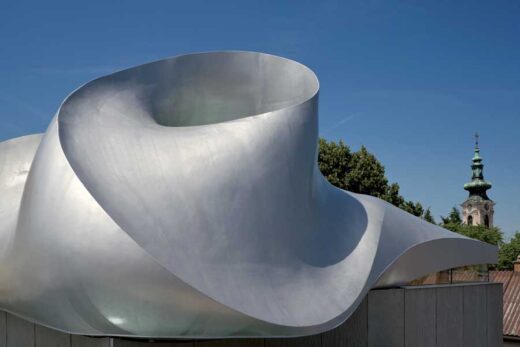
photo © Duccio Malagamba
Martin Luther Church Hainburg, Austria
(2008-2011)
Architectural Concept
In less than a year a protestant church together with a sanctuary, a church hall and supplementary spaces was built in the centre of the Lower Austrian town Hainburg, at the site of a predecessor church that doesn’t exist anymore since the 17th century.
The shape of the building is derived from that of a huge “table”, with its entire roof construction resting on the legs of the “table” – four steel columns. Another key element is the ceiling of the prayer room: its design language has been developed from the shape of the curved roof of a neighboring Romanesque ossuary – the geometry of this century-old building is translated into a form, in line with the times, via today’s digital instruments.
The play with light and transparency has a special place in this project. The light comes from above: three large winding openings in the roof guide it into the interior. The correlation of the number Three to the concept of Trinity in the Christian theology can be interpreted as a “deliberate coincidence”.
The church interior itself is not only a place of mysticism and quietude – as an antithesis of our rather fast and media-dominated times – but also an open space for the community.
The sanctuary gives access to the glass-covered children’s corner, illuminated by daylight, which accommodates also the baptistery. The actual community hall is situated behind it: folding doors on the entire length of the space between the two main chambers allow for combining them to one continuous spatial sequence. An folded glass façade on the opposite side opens the space towards the street.
A third building element, a longitudinal slab building along a small side alley, flanks both main spaces and comprises the sacristy, the pastor’s office, a small kitchen and other ancillary rooms. A handicapped accessible ramp between the three building components accesses the church garden on higher ground.
The sculptural bell tower at the forecourt constitutes the fourth element of the building ensemble.
View Prayer room and altar / Ansicht Gottesdienstraum-Altar:
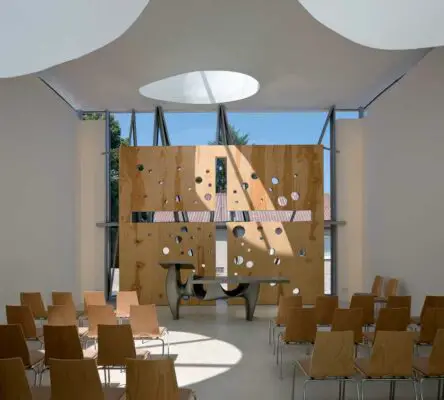
photo © Duccio Malagamba
Technical Description
Due to its shape with three skylights the roof of the Martin Luther Church in Hainburg was designed as a self-supporting steel construction with a stucco ceiling. The structure was assembled in a wharf at the Baltic Sea. The exterior skin is made of 8 mm thick three-dimensionally curved steel plates welded on a frame construction. In turn, this structure of steel plates and frame sits on a girder grid. The compound of grid, frame and steel skin transfers the total load of the roof (23 tons) on four steel columns which are based on the solid concrete walls of the prayer room.
The roof construction was delivered in four separate parts to Hainburg, assembled and welded on site. There, the coating of the whole structure was finished and mounted with a crane in the designated position on the shell construction of the prayer room.
On the interior ceiling the suspended frame structure was covered in several layers of steel fabric and rush matting as carrier layer for the cladding of the stucco ceiling, whose geometry follows the three-dimensionally curved shape of the roof with the skylights.
The free-form bell tower of the Martin Luther Church was also manufactured, by means of shipbuilding technology, as a vertical self-supporting steel structure with wall thickness between 8 and 16 millimeter, only braced by horizontal frames. The 20 meter high tower weighing 8 tons is welded rigidly to a steel element encased in the concrete foundations.
Prayer room and community hall / Gottesdienstraum mit Blick zur Erschliessungszone:
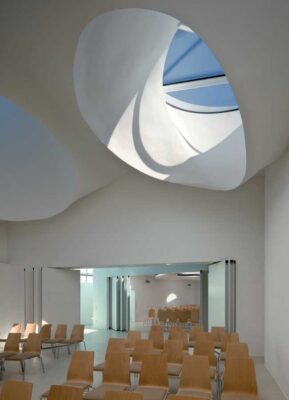
photo © Duccio Malagamba
Martin Luther Kirche Hainburg – Building Information
Design Team
Planning:
COOP HIMMELB(L)AU
Wolf D. Prix / W. Dreibholz & Partner ZT GmbH
Design Principal: Wolf D. Prix
Project Architect: Martin Mostböck
Design Architect: Sophie-Charlotte Grell
Project Team: Steven Baites, Daniel Bolojan, Victoria Coaloa, Volker Kilian, Martin Neumann, Martin Jelinek
Client: Association „Freunde der Evangelischen Kirche in Hainburg/Donau”, Austria
User: Evangelische Pfarrgemeinde A.B. Bruck a.d. Leitha – Hainburg/Donau, Austria
Structural engineering: Bollinger Grohmann Schneider ZT GmbH, Vienna, Austria
Construction survey: Spirk & Partner ZT GmbH, Vienna, Austria
Main works / finishing: Markus Haderer Baubetrieb Ges.m.b.H, Hainburg/Donau, Austria
Steel construction (roof/ tower): OSTSEESTAAL GmbH, Stralsund, Germany
Steel Construction (façade): Metallbau Eybel, Wolfsthal, Austria
Fibre cement cladding: Eternit-Werke Ludwig Hatschek AG, Vöcklabruck, Österreich SFK GmbH, Kirchham, Austria
Altar: Idee & Design, Stainz, Austria
Project Data
Site area: 420 m²
Sanctuary for 50 people, community space und ancillary rooms
Total gross floor area: 289 m²
Height (slab building / community space): 3,5 m
Height sanctuary: 6 m
Height roof: 10 m
Length: 25 m
Width: 10-17 m
Height bell tower: 20 m
Chronology
Start of Planning: 2008
Start of Construction: 08/2010
Opening: 04/2011
The Geometry of the Church Roof / Die Geometrie des Kirchendaches:
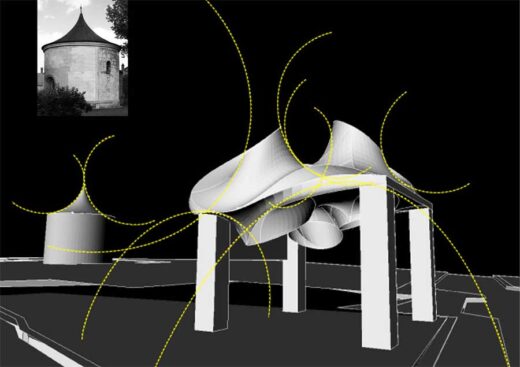
image © COOP HIMMELB(L)AU
Martin Luther Kirche Hainburg images / information from COOP HIMMELB(L)AU
COOP HIMMELB(L)AU design for church in Hainburg, Austria
(Vienna, March 26, 2009) Wolf D. Prix, design principal of COOP HIMMELB(L)AU donates a design for the new Dr. Martin Luther Church in Hainburg, Austria to the protestant church. The completion of the project is planned for 2011.
On the site of a previously existing church in the center of Hainburg, Lower Austria, a protestant church with prayer hall, community hall and other spaces will be built.
On the level of form, the project is influenced on the one hand by immediately surrounding buildings. Its complex roof landscape variegates the architectural language of the saddleback roofs, which are common in the region, and of the roof of the romanesque ossuary close by. On the other hand, its individual geometry also expresses a certain spiritual symbolism, like with the prayer hall in the shape of a very large table. Three skylights resting on the four legs of this table are inserted in the roof construction.
On the side of the main road the church has the most transparent and open appeal; its folded, zigzagging glass façade invites the visitor into the high prayer room. Yet its intimacy is conserved by a symbolic wooden wall, standing free just behind the glass façade. An illuminated cross-shaped opening in this wall projects the simple message of the church into the urban space.
From the prayer hall the visitor reaches the daylit, glass-roofed children zone and the baptistry. Behind, the community hall is situated. Large folding doors between the two large halls allow to open and join the whole spatial sequence to one continuous space. A third building component at a smaller alley is situated next to the two main halls and houses the sacristy, the pastor’s office, a small kitchen and other service spaces. A handicapped-friendly ramp leads between the buildings to the community garden. The fourth element of the ensemble is the delicate sculpture of the bell tower on the forecourt.
Wolf D. Prix describes the project as follows:
“The roof of the church is a further development of the roof of the charnel house. While designing the church roof we dedicated special attention the atmospheric illumination of the interior space through its special orchestration of light. On one hand the open wall is an inviting gesture; on the other hand a special atmosphere will be generated by closing the wall with a curtain so that the light just penetrates from above. I am very pleased that my hometown Hainburg will have a modern building.”
Dr. Martin Luther Church Hainburg, Austria
2008-2011
Hainburg Church Austria information from COOP HIMMELB(L)AU 260309
Location: Hainburg, Austria, central Europe
Austrian Building Designs
Austrian Architecture Designs – architectural selection below:
Vienna Architecture Walking Tours by e-architect
Austria Architect : Studio Listings
Pharmaceutical Institute and Laboratory, Strubergasse 15, 6020 Salzburg
Design: Berger+Parkkinen
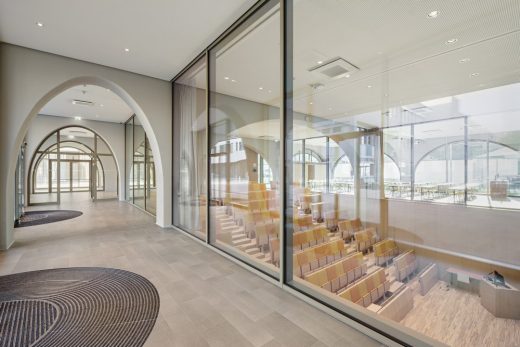
photo © Hertha Hurnaus
Pharmaceutical Institute and Laboratory in Salzburg
ASI Reisen Offices, Natters, Innsbruck
Architects: Snøhetta
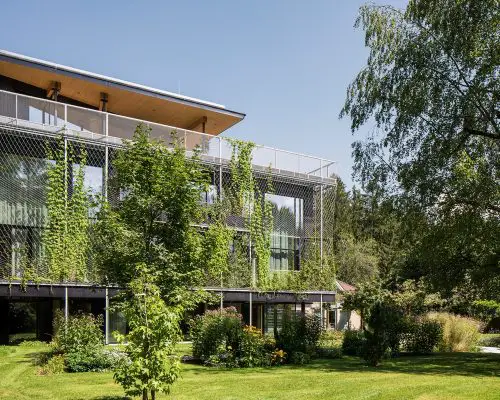
photo : LITE Studio
ASI Reisen Offices
Skyspace, Arlberg Region
Architects: Baumschlager Eberle Architekten
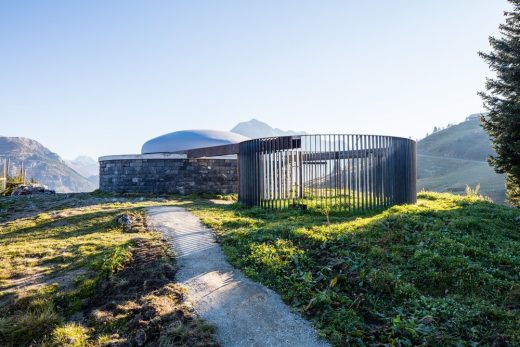
photograph © Florian Holzherr
Skyspace Arlberg Region
KTM Motohall, Mattighofen, Austria
Architects: Atelier Brueckner
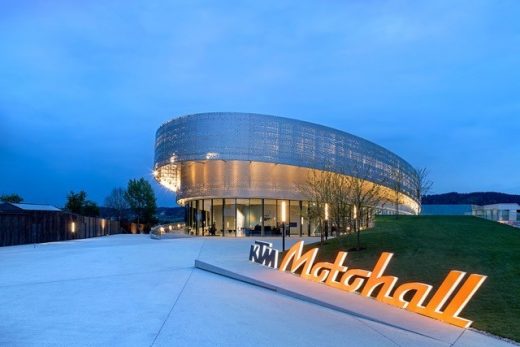
photography © Daniel Stauch
KTM Motohall Mattighofen
Loft Panzerhalle, Salzburg
Design: smartvoll Architekten ZT KG
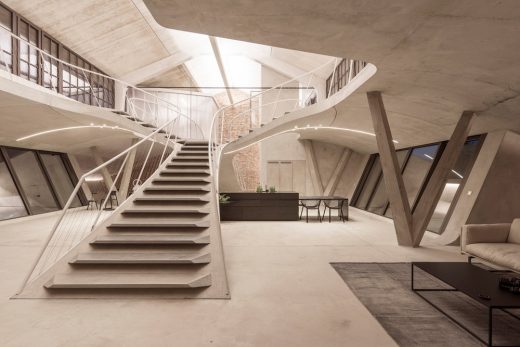
photography: Tobias Colz/smartvoll
Loft Panzerhalle in Salzburg
Villa in Upper Austria
Design: TWO IN A BOX
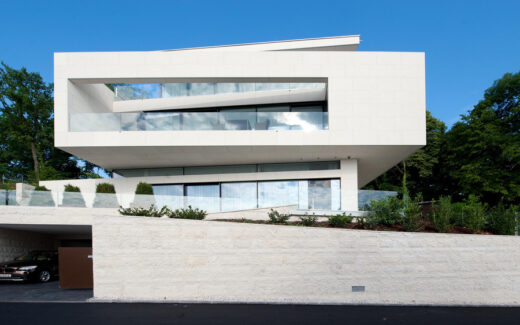
photo : Mag. Dietmar Tollerian – © ARCHIPICTURE.AT
Villa in Upper Austria
Austrian Architecture – Selection
Reißeck Top Terminal
Zechner & Zechner ZT GmbH
Reißeck Top Terminal
Raiffeisen Finance Center, Eisenstadt
Pichler & Traupmann Architekten
Raiffeisen Finance Center
Sofitel Vienna Stephansdom
Ateliers Jean Nouvel
Sofitel Vienna Stephansdom
A recent design by COOP HIMMELB(L)AU: Art Museum Strongoli, Calabria
Comments / photos for the Hainburg Church Austria Architecture design by COOP HIMMELB(L)AU page welcome

